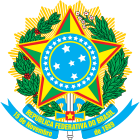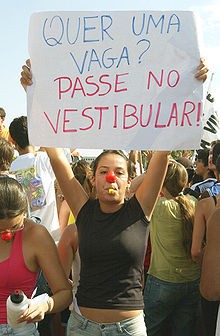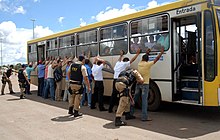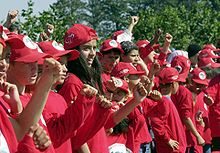Human rights in Brazil
| This article is part of a series on the |
 |
|---|
Human rights in Brazil include the right to life and freedom of speech; and condemnation of slavery and torture. The nation ratified the American Convention on Human Rights.[1] The 2017 Freedom in the World report by Freedom House gives Brazil a score of "2" for both political rights and civil liberties; "1" represents the most free, and "7", the least.[2]
However, the following human rights problems have been reported: torture of detainees and inmates by police and prison security forces; inability to protect witnesses involved in criminal cases; harsh conditions; prolonged pretrial detention and inordinate delays of trials; reluctance to prosecute as well as inefficiency in prosecuting government officials for
Slave labor and labor exploitation


Slavery is illegal in Brazil.
In 2014, Brazil is still classified in a U.S. Department of Labor report as one of the 74 countries that still employ children and slave laborers within the informal working sector. A List of Goods Produced by Child Labor or Forced Labor issued within the report shows 16 products including cotton, cashews, pineapples, rice and sugarcane[10] corresponding to the country of Brazil.
Human rights abuse isn't limited to just the local population but to foreign domestic workers as well. In 2017, a
Domestic violence


On August 7, 2006, former Brazilian President Luiz Inácio Lula da Silva signed a law on domestic and family violence against women in Brasília.[12]
Ethnic minorities

Although the law prohibits
Major public universities in the Federal District and the states of São Paulo, Rio de Janeiro, Paraná, Mato Grosso, Minas Gerais, Espírito Santo, Bahia, and others maintained affirmative action programs. For instance, the University of Brasília set aside 25 percent of its first-year 2007 vacancies for self-declared students of color. According to a study from Rio de Janeiro Federal University released in January, approximately half of the public federal and state universities had a quota system or an exam bonus.[13]
The law grants the
Women's rights

Women have the same legal rights as men. A cabinet-level office, the Secretariat for Women's Policy, oversees a special entity charged with ensuring the legal rights of women. Although the law prohibits discrimination based on gender in employment and wages, there were significant wage disparities between men and women. According to the Ministry of Labor and Employment (MTE), women were often paid less than men in the same functions.
The law provides 120 days of paid maternity leave to women and seven days of
Prostitution is legal, but exploiting it through associated activities, such as operating a brothel, is illegal. While no specific laws address sex tourism, it is punishable under other criminal offenses, and there was a government-released "code of conduct to combat sex tourism and sexual exploitation" and government-conducted campaigns in the most affected areas.
The Federal District and the states of
Each state secretariat for public security operated "
The stations provided psychological counseling, temporary shelter, and hospital treatment for victims of domestic violence and rape (including treatment for HIV and other sexually transmitted diseases) as well as criminal prosecution assistance by investigating and forwarding evidence to courts. There were also 123 reference centers and 66 women's shelters.
In Rio de Janeiro, the city's Rio Women Program provided assistance to female victims of domestic violence who received death threats. When necessary, victims were sent to specific shelters, which also provided psychological and legal aid. In addition to the Women Program, victims of domestic violence could obtain assistance at the Center for Women's Support, an initiative of the Rio de Janeiro state government that offered a complaint hot line, shelters, and psychological and legal aid.
The law requires
In the
Prisoner violence
The Brazilian prison system is considered insolvent for a long time. Prisons are overcrowded and unhealthy, and
Prison conditions throughout the country often range from poor to extremely harsh and life-threatening. Abuse by prison guards, poor medical care, and severe overcrowding occurred at many facilities. Prison officials often resorted to brutal treatment of prisoners, including torture, harsh or dangerous working conditions, official negligence, poor sanitary conditions, abuse and mistreatment by guards, and a lack of medical care led to a number of deaths in prisons. Poor working conditions and low pay for prison guards encouraged widespread corruption. Prisoners who committed petty crimes were held with murderers. According to the National Penitentiary Department, in June there were 392,279 prisoners incarcerated, 40 percent more than the system's design capacity, and the number increased approximately 3,000 per month. During the year 135 prisoners were involved in riots from January to June in federal prisons. There were several official complaints of overcrowding in Goiás, Rio de Janeiro, São Paulo, and Minas Gerais states.[18]
Summary executions and police violence

Police violence is one of the most internationally recognized human rights abuses in Brazil. The problem of urban violence focuses on the perpetual struggle between police and residents of high crime favelas such as the areas portrayed in the film City of God and mainly Elite Squad.
Police response in many parts of Brazil is extremely violent, including
Reports of killings by Rio de Janeiro police decreased during the year under a new state security strategy. Statistics released by the
There were no
Torture
Brazil's 21-year military dictatorship, ushered in with a U.S.-backed coup in 1964, tortured thousands of Brazilian citizens—anyone even suspected of opposing the authoritarian regime. As of 1988, torture is illegal in Brazil.
Federal, state, and military police often enjoyed impunity in cases of torture, as in other cases of abuse. During the year an additional state (for a total of 13 of 26) adopted the National Plan for the Prevention and Control of Torture, which includes the installation of cameras in prisons and penitentiaries, taping of interrogations, and reversal of the presumption of innocence for those accused of torture.[citation needed]
During the first half of the year, [
The Rio de Janeiro military police officer, who publicly defended the use of torture in 2007 and was subsequently transferred, was assigned command of the 38th Military Police Battalion in Três Rios. The nine police officers, including the police chief of Osasco, São Paulo, charged in 2007 with theft, torture, extortion, beating, and threatening to rape to extort money, remained free and continued to await a trial that at year's end was not scheduled. In October 2007 the Inter-American Commission on Human Rights (IACHR) adopted several findings in a case originated in 1998, that authorities had violated the rights of Antonio Ferreira Braga by illegally arresting and torturing him in 1993 in Ceará State, and that the government had failed to prevent and punish said acts, and also made four recommendations. After various exchanges the IACHR announced on July 18 that the government had fulfilled one recommendation (training police on humane treatment), but not two others (investigation and punishment of those responsible, compensation of the victim), and that one remained pending (investigation of possible negligence of authorities).[21]
Agrarian violence and oppression

The agrarian struggle in Brazil is manifold, touching on the topics of deforestation,
Other cases of agrarian human rights violations involve invasion of properties and taking landowners as hostages, in order to force the government to provide land for the Landless Worker's Movement. Further agrarian violence arises from smugglers of exotic animals, wood, and other minerals from extracting contraband from forest or agrarian areas.[
Indigenous violence

As
The law provides indigenous persons with exclusive beneficial use of the soil, waters, and minerals on indigenous lands, but Congress must approve each case. The government administers the lands but must consider the views of affected communities regarding their development or use, and communities have the right to profit from such use. However, indigenous leaders and activists complained that indigenous peoples had only limited participation in decisions taken by the government affecting their land, cultures, traditions, and allocation of national resources.
It is also criticized the government for devoting insufficient resources to health care, other basic services, and protection of indigenous reserves from outsiders. Non-indigenous people who illegally exploited indigenous lands for mining, logging, and agriculture often destroyed the environment and wildlife and caused violent confrontations.
Refugees
The law provides for the granting of asylum or refugee status in accordance with the 1951 UN Convention relating to the Status of Refugees and its 1967 protocol, and the government has established a system for providing protection to refugees. In practice the government provided protection against the expulsion or return of refugees to countries where their lives or freedom would be threatened.
The government provided temporary protection to individuals who may not qualify as refugees under the 1951 convention and the 1967 protocol. The government cooperated with the Office of the
The UNHCR estimated that approximately 600 persons fled to the country from the September conflict in
From 1998 to 2008, 4,515
Violence against human rights defenders
Many human rights defenders who have arisen to oppose human rights violations and their families and friends suffer violence and persecution across Brazil. Telephone death threats are prominent and often followed through by ambush or assassination.[citation needed]
Government officials, attorneys, union leaders and even religious leaders have often been targeted, as with Antonio Fernandez Saenz affair. The danger of human rights defense entered the world press with the murder of Dorothy Stang in 2005, and Chico Mendes in 1988.[28]
On 11 April 2022, the Office of the United Nations High Commissioner for Human Rights(OHCHR) issued a statement condemning the restrictions on Brazilians’ rights to full and active social and political participation, and the appalling levels of violence directed against human rights defenders, women journalists, indigenous peoples and traditional communities in particular of African-descent.[29]
LGBT rights

Lesbian, gay, bisexual, and transgender (LGBT) people in Brazil enjoy many of the same legal protections available to non-LGBT people, with LGBT people having marriage rights available nationwide since May 2013.
The
See also
- Anti-discrimination laws in Brazil
- Social apartheid in Brazil
- Women's rights in Brazil
- Heráclito Fontoura Sobral Pinto
- Candelária massacre (1993)
- Carandiru massacre (1992)
- Complexo do Alemão massacre (2007)
- Police brutality in Brazil
References
![]() This article incorporates public domain material from 2008 Human Rights Report: Brazil. United States Department of State.
This article incorporates public domain material from 2008 Human Rights Report: Brazil. United States Department of State.
- ^ "Multilateral Treaties - AMERICAN CONVENTION ON HUMAN RIGHTS "PACT OF SAN JOSE, COSTA RICA" (B-32)". Organization of American States. Retrieved July 11, 2017.
- ^ "Brazil - Freedom in the World 2017". Freedom House. Archived from the original on July 8, 2019. Retrieved May 4, 2021.
- ^ "Brazil - World - Americas". Human Rights Watch. Retrieved July 11, 2017.
- ^ "Brazil 2016/2017". Amnesty International. Retrieved July 11, 2017.
- ^ a b "ENGLISH VERSION of Human Rights Complaint Document submitted to the United Nations OHCHR by the National Indigenous Peoples Organization from Brazil (APIB)". EARTH PEOPLES. November 13, 2012. Archived from the original on April 1, 2019. Retrieved November 19, 2012.
- ^ "Human rights in Brazil". State.gov. February 25, 2009. Archived from the original on February 26, 2009. Retrieved October 21, 2010.
- ^ "Human Rights in Brazil". UNESCO. United Nations. Retrieved July 11, 2017.
- ^ a b Kersten, Ignácio Mendez. "A Constituição do Brasil e os Direitos Humanos" (in Brazilian Portuguese). Archived from the original on February 15, 2019. Retrieved July 11, 2017.
- ^ "BBC news, major raid in slave farm". BBC News. July 3, 2007. Retrieved October 21, 2010.
- ^ List of Goods Produced by Child Labor or Forced Labor
- ^ Bachega, Hugo (December 11, 2017). "The housemaid's tale: 'I ate dog food to survive'". BBC News. Retrieved December 11, 2017.
- ^ "Maria da Penha Law". Unifem.org. Retrieved October 21, 2010.
- ^ "Quotas for Afro-brazilians". State.gov. February 25, 2009. Archived from the original on February 26, 2009. Retrieved October 21, 2010.
- ^ "Indigenous situation in Brazil". State.gov. February 25, 2009. Archived from the original on February 26, 2009. Retrieved October 21, 2010.
- ^ "Women rights in Brazil". State.gov. February 25, 2009. Archived from the original on February 26, 2009. Retrieved October 21, 2010.
- ^ a b "Amnesty International report on Brazil". Archived from the original on June 10, 2009.
- ^ Barrionuevo, Alexei (December 12, 2007). "Rape of Girl, 15, Exposes Abuses in Brazil Prison System". The New York Times. Retrieved December 13, 2007.
- ^ "The situation of Brazilian prisons and human rights". State.gov. February 25, 2009. Archived from the original on February 26, 2009. Retrieved October 21, 2010.
- ^ "Police violence and Human rights". State.gov. February 25, 2009. Archived from the original on February 26, 2009. Retrieved October 21, 2010.
- S2CID 153427610.
- ^ "Torture in Brazil". State.gov. February 25, 2009. Archived from the original on February 26, 2009. Retrieved October 21, 2010.
- ^ Refugees, United Nations High Commissioner for. "Refworld | 2016 Country Reports on Human Rights Practices - Brazil". Refworld. Retrieved October 7, 2020.
Paramilitary forces acting on instructions of wealthy land owners allegedly carried out the attack as a reprisal against the indigenous community for seeking recognition of their land rights.
- S2CID 154398518.
- ^ "Brazil's Landless Workers Rise Up". Dissent Magazine. Retrieved October 7, 2020.
- ^ "Indigenous rights in Brazil". State.gov. February 25, 2009. Archived from the original on February 26, 2009. Retrieved October 21, 2010.
- ^ "Brazil Analyzing Violence Against the Amazon's Residents". HumanRightsWatch. May 26, 2020. Retrieved May 26, 2020.
- ^ "Refugees in Brazil". State.gov. February 25, 2009. Archived from the original on February 26, 2009. Retrieved October 21, 2010.
- ^ Sources: Human Rights Watch, Global Justice, Pastoral Land Commission
- ^ "Brazil: UN expert decries erosion of democracy, urges safe space for civil society". OHCHR. Retrieved April 11, 2022.
- ^ Brocchetto, Marilia (May 15, 2013). "Brazilian judicial council orders notaries to recognize same-sex marriage". CNN. Retrieved July 11, 2017.
- ^ "Brazil Supreme Court awards gay couples new rights". BBC News. May 6, 2011. Retrieved July 11, 2017.
- ^ "São Paulo Gay Parade". Retrieved July 11, 2017.
- ^ "Censo mostra que o Brasil tem 60 mil casais gay com união estável" (in Brazilian Portuguese). Archived from the original on March 15, 2012. Retrieved July 11, 2017.
- ^ "Parada gay de Curitiba com cunho político" (in Brazilian Portuguese). Archived from the original on July 15, 2015. Retrieved July 11, 2017.
- ^ "Jovens se mobilizam contra homofobia" (in Brazilian Portuguese). Archived from the original on July 15, 2015. Retrieved July 11, 2017.
Further reading & external links
- Zimbardo, et al. Violence Workers
- France Winddance Twine "Racism in a Racial Democracy"
- Hub.witness.org, "Bound by Promises", video co-produced by Witness and Comissão Pastoral da Terra (CPT) about slave labor.
- UN.org, "Review of Brazil" by the United Nations Human Rights Council's Universal Periodic Review, April 11, 2008
